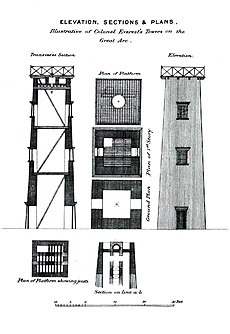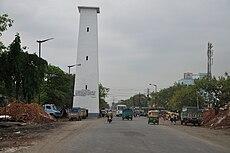Great Trigonometrical Survey

TheGreat Trigonometrical Survey of Indiawas a project that aimed to carry out asurveyacross theIndian subcontinentwith scientific precision. It was begun in 1802 by theBritish infantryofficerWilliam Lambton,under the auspices of theEast India Company.[1]Under the leadership of his successor,George Everest,the project was made the responsibility of theSurvey of India.Everest was succeeded byAndrew Scott Waugh,and after 1861, the project was led byJames Walker,who oversaw its completion in 1871.
Among the many accomplishments of the Survey were the demarcation of theBritishterritories in the subcontinent and the measurement of the height of theHimalayangiants:Everest,K2,andKangchenjunga.The Survey had an enormous scientific impact as well. It was responsible for one of the first accuratemeasurementsof a section of an arc oflongitude,and for measurements of thegeodesic anomaly,which led to the development of the theories ofisostasy.
The native surveyors made use of in the Himalayas, especially inTibet(where Europeans were not allowed), were calledpundits,who included the cousinsNain Singh RawatandKrishna Singh Rawat.[2][3][4]

History
[edit]From its inception in 1600 to its domination of the entireIndian subcontinentby the beginning of the nineteenth century, theBritish East India Companygained more and more territory.[1]With the acquisition of new territory, it employed several explorers and cartographers to provide maps and other information on its territories, most notablyJames Rennell,from 1767 inBengal.As Rennell proceeded to make maps, the lack of precise measurement was noticed.[1]In 1800, shortly after the Company victory overTipu Sultan,William Lambton, an infantry soldier with experience in surveying, proposed to remedy precisely that, through a series oftriangulations,initially through the newly-acquired territory ofMysore,and eventually across the entiresubcontinent.[5]


The Great Trigonometrical Survey of India started on 10 April 1802 with the measurement of a baseline nearMadras.[1]Major Lambton selected the flat plains withSt. Thomas Mountat the north end and Perumbauk hill at the southern end. The baseline was 7.5 miles (12.1 km) long. Lieutenant Kater was despatched to find high vantage points on the hills of the west so that the coastal points ofTellicherryandCannanorecould be connected. The high hills chosen wereMount DellyandTadiandamol.The distance from coast to coast was 360 miles (580 km) and this survey line was completed in 1806.[7]The East India Company thought that this project would take about five years, but it took nearly 70 years, well past theIndian Rebellion of 1857and the end ofcompany rule in India.Because of the extent of the land to be surveyed, the surveyors did nottriangulatethe whole of India but instead created what they called a "gridiron" of triangulation chains running from north to south and east to west.[1]At times the survey party numbered 700 people.[8]
The Trigonometrical Survey was conducted independently of other surveys, notably the topographical and revenue surveys. In 1875, the decision was taken that the Survey budget should be reduced from 240,000 to 200,000 pounds. This resulted in a reorganization under Surveyor-General Colonel J.T. Walker to amalgamate the Great Trigonometrical, Topographical and Revenue Surveys into the Survey of India.[9]

Instruments and methods used
[edit]Triangulation surveys were based on a few carefully measured baselines and a series of angles. The initial baseline was measured with great care since the accuracy of the subsequent survey was critically dependent upon it. Various corrections were applied, principally temperature. An especially accuratefolding chainwas used, laid on horizontal tables, all shaded from the sun and with constant tension. The early surveys made use of large and bulkytheodolitesmade by William Carey,[10]azenith sectormade byJesse Ramsden,and 100-foot (30 m) chains. Later surveys used more compact theodolites.

Accurate instruments could not always be purchased through the standard system of government contract, and Everest personally supervised the construction of instruments. He had a maker, Henry Barrow, set up an instrument company in Calcutta. Barrow was succeeded by Syed Mohsin fromArcot, Tamil Nadu,and after his death, the instruments were supplied by Cooke fromYork.[11][12]
Correcting deviations
[edit]To achieve the highest accuracy, a number of corrections were applied to all distances calculated from simple trigonometry:
- Curvature of the Earth
- The non-spherical nature of the curvature of the Earth
- Gravitationalinfluence of mountains onpendulumsand plumb lines[13]
- Refraction
- Height above mean sea level
Superintendents
[edit]- 1818–1823 –William Lambton
- 1823–1843 –Sir George Everest
- 1843–1861 –Andrew Scott Waugh
- 1861–1883 –James Thomas Walker
- 1884–1888 –Charles Thomas Haig
- 1888–1894 –George Strahan
- 1894–1899 –St George Corbet Gore
- 1899–1911 –Sidney Gerald Burrard
- 1912–1921 –Sir Gerald Ponsonby Lenox-Conyngham
See also
[edit]Notes
[edit]References
[edit]- ^abcdeGill, B. (2001); "THE BIG MAN. Surveying Sir George Everest", in:Professional Surveyor Magazine,Vol. 21 Nr 2. RetrievedonlineArchived10 February 2017 at theWayback Machine8 March 2016.
- ^Peter Hopkirk, 1982, "Trespassers on the Roof of the World: The Race for Lhasa",Oxford UniversityPress.
- ^Derek J. Waller, 2004, "The Pundits: British Exploration of Tibet and Central Asia,"University Press of Kentucky.
- ^Account of the Pundit's Journey in Great Tibet - Capt. H. Trotter, The Journal of the Royal Geographical Society (1877).
- ^Lambton, William (1811)."An account of the Trigonometrical Operations in crossing the peninsula of India, and connecting Fort St. George with Mangalore".Asiatic Researches; or Transactions of the Society Instituted in Bengal for Inquiring into the History and Antiquities:290–384.
- ^"bone, v.3".Oxford English Dictionary(Online ed.).Oxford University Press.(Subscription orparticipating institution membershiprequired.)
- ^Markham, Clements(1878).A Memoir on the Indian Surveys(2 ed.). London. W H Allen And Co. p.67.Retrieved1 March2009.
- ^Bluesci: Cambridge university science magazine,29 January 2011, "History: The Great Trigonometrical Survey""BlueSci » History: The Great Trigonometrical Survey".Archived from the original on 27 July 2014.Retrieved5 May2013.
{{cite web}}:CS1 maint: bot: original URL status unknown (link),Cambridge. - ^Black, Charles E.D. (1891).A memoir of the Indian Surveys, 1875–1890.London: Secretary of State for India in Council. pp. 39–40.
- ^R., Ramachandran (2 June 2021) [Originally appeared in print version on April 27, 2002]."Survey Saga".frontline.thehindu.com.Retrieved26 December2022.
- ^Strahan, C. (1903)."The Survey of India".Professional Papers of the Corps of Royal Engineers.28:141–171.
- ^Insley, Jane (1995)."Making mountains out of molehills? George Everest and Henry Barry, 1830–39"(PDF).Indian Journal of History of Science.30(1): 47–55. Archived fromthe original(PDF)on 25 January 2014.
- ^Pratt, John Henry (1855)."On the Attraction of the Himalaya Mountains, and of the Elevated Regions beyond Them, upon the Plumb-Line in India".Philosophical Transactions of the Royal Society of London.145:53–100.doi:10.1098/rstl.1855.0002.JSTOR108510.
Further reading
[edit]- Edney, Matthew H. (2009).Mapping an Empire: The Geographical Construction of British India, 1765-1843.University of Chicago Press.ISBN978-0-226-18486-9.
- John Keay.2000.The Great Arc,London: Harper Collins.ISBN0-00-257062-9.
- Dean, Riaz (2019).Mapping The Great Game: Explorers, Spies & Maps in Nineteenth-century Asia.Oxford: Casemate (UK). pp. 67–123.ISBN978-1-61200-814-1.
- Deb Roy, Rama (1986),"The Great Trigonometrical Survey of India in a Historical Perspective"(PDF),Indian Journal of History of Science,21(1): 22–32, archived fromthe original(PDF)on 25 January 2014
- Reginald Henry Phillimore,Historical Records of the Survey of India,5 vols. Dehra Dun, Survey of India (1945–1968)
